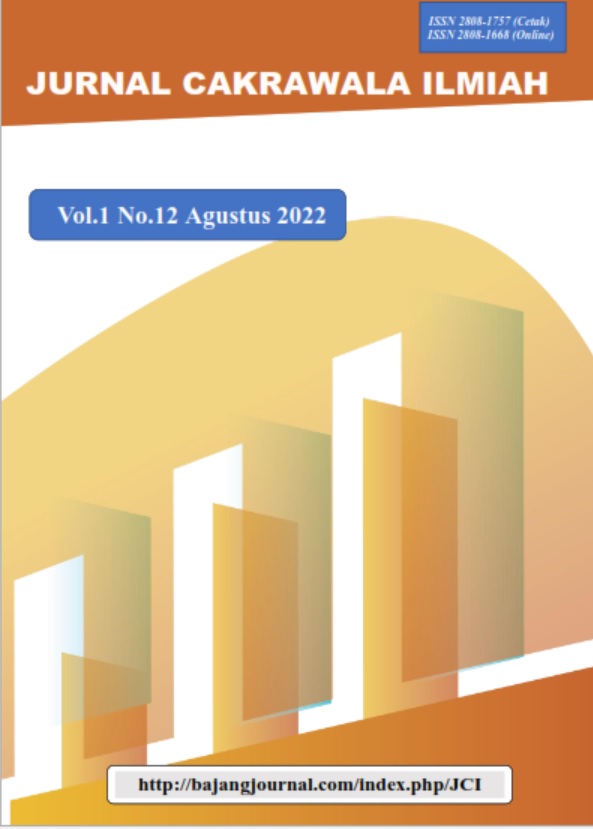ENERGY SECURITY POLICY OF PT. PERTAMINA FACES THE DYNAMICS OF FOREIGN POLICY
DOI:
https://doi.org/10.53625/jcijurnalcakrawalailmiah.v1i12.3609Keywords:
Energy Security, Foreign Policy, PT. PertaminaAbstract
: Indonesia is a country that has diversity abundant natural resources, including energy resources. Indonesia's role in the energy sector is very large, for example Indonesia is one of the exporters of coal and LNG (Liquefied Natural Gas) is the largest in the world. Wealth is real is the capital to become a great country. PT. Pertamina (Persero) as a national-scale oil company that has been committed to providing the best contribution to the Indonesian economy. The research method uses descriptive qualitative. The results of the study show that Kube 1998 includes five main policy and nine policies supporters. The main policies are: Diversification is diversification use of energy, both renewable or non-renewable. Intensification is the search for energy sources through survey and exploration activities so that can upgrade new reserve especially fossil energy. Conservation is carried out starting from the upstream side down to the bottom. The main target of Pertamina's policy related to the protection of biodiversity is ecosystems located in/close to Pertamina's working areas, both on land and in sea. Determination of the average energy price which gradually directed to follow the mechanism market and Paying attention to environmental aspects in development in the energy sector including in it gives priority in utilization of clean energy. The novelty of this research is PT. Pertamina Faces The Dynamics Of Foreign Policy seeks to increase its role in driving the national economy by developing strategies to meet national energy in a sustainable manner and reduce imports of oil and gas
References
Bappenas. (2012). Policy paper: keselarasan kebijakan energi nasional (KEN) dengan Rencana Umum Energi Nasional (RUEN) dan Rencana Umum Energi Daerah (RUED). 49. https://www.bappenas.go.id/files/6214/7547/7522/Policy_Paper_KEN_RUEN_RUED_2012.pdf
Bhattacharya, M., Paramati, S. R., Ozturk, I., & Bhattacharya, S. (2016). The effect of renewable energy consumption on economic growth: Evidence from top 38 countries. Applied Energy, 162, 733–741.
BIN, B. I. N. (2016). Ketahanan Energi Indonesia 2015-2025 Tantangan dan Harapan. Rumah Buku.
Brundtland, G. H., Khalid, M., & others. (1987). Our common future. Oxford University Press, Oxford, GB.
Chandra, P. (1999). Changing Dimensions of the Communal Politics in India. Dominant Publishers and Distributors.
Chester, L. (2010). Conceptualising energy security and making explicit its polysemic nature. Energy Policy, 38(2), 887–895.
Duha, J., & Saputro, G. E. (2022). Blue Economy Indonesia to Increase National Income through the Indian Ocean Rim Association (IORA) in the Order to Empower the World Maritime Axis and Strengthen State Defense. JMKSP (Jurnal Manajemen, Kepemimpinan, Dan Supervisi Pendidikan), 7(2), 514–527.
Dye, R. T. (2005). Understanding Public Policy, by Person Education. Inc, Upper Saddle River, New Jersey, USA.
Farid, M. (2017). Keamanan Energi Dalam Politik Luar Negeri Indonesia. Jurnal Ilmu Hubungan Internasional.
Guba, E. G., & Lincoln, Y. S. (1988). Do inquiry paradigms imply inquiry methodologies. Qualitative Approaches to Evaluation in Education, 1(1), 89–115.
Hadiwinata, B. S. (2021). Bringing the State Back In: Energy and National Security in Contemporary International Relations. Global: Jurnal Politik Internasional, 8(2), 1–17.
Holsti, K. J. (1919). International politics: A framework for analysis. -.
Keliat, M. (2021). Kebijakan Keamanan Energi. Global: Jurnal Politik Internasional, 8(2), 33–47.
Kleveman, L. (2003). The new great game: blood and oil in Central Asia. Grove Press.
Moleong, L. J. (2007). Metodologi Penelitian Kualitatif. PT Remaja Rosdakarya.
Muna, M. R. (2011). Tinjauan Atas Kebijakan Nasional untuk Keamanan Energi: Upaya Menciptakan Energi Hijau dan Pemanfaatan EBT. Prosiding Kongres Ilmu Pengetahuan Nasional X Tanggal, 8–11.
Mundir, M. (2013). Metode penelitian kualitatif dan kuantitatif. STAIN Jember Press.
Nasional, D. E. (2015). Ketahanan Energi Indonesia. Jakarta: Sekjen DEN.
Plano, J. C., & Olton, R. (1999). Kamus Hubungan Internasional, terj. Wawan Juanda, Putra Abardin.
Smith, R., & Smith, L. (2018). Qualitative methods. In Research methods in human rights (pp. 70–93). Routledge.
Sugiyono, A. (2014). Permasalahan dan kebijakan energi saat ini. Prosiding Peluncuran Buku Outlook Energi Indonesia 2014 & Seminar Bersama BPPT Dan BKK-PI. Jakarta: Badan Pengkajian Dan Penerapan Teknologi, 9–16.
Voyer, M., Quirk, G., McIlgorm, A., & Azmi, K. (2018). Shades of blue: what do competing interpretations of the Blue Economy mean for oceans governance? Journal of Environmental Policy & Planning, 20(5), 595–616.
Wesley, M. (2007). Energy security in Asia (Vol. 3). Routledge London.
Yergin, D. (2006). Ensuring energy security. Foreign Affairs, 69–82.
Yusgiantoro, P. (2000). Ekonomi Energi: Teori dan Praktik. LP3ES.
















